- Details
- Last Updated: Thursday, 29 May 2025 06:08
- Written by IELTS Mentor
- Hits: 109124
Answer explanation for Academic Reading Passage Sample 2 Visual Symbols and the Blind.
Go to the Reading Passage - Visual Symbols and the Blind.
Answer Explanation:
Question 27: In the first paragraph, the writer makes the point that blind people...
Answer: C.
Explanation: This is a bit tricky question as your quick scanning method would allure you to consider 'B' (can draw outlines of different objects and surfaces) as the right answer. However, this is not the case. Read more attentively and find the underlying meaning of the sentence-
"...it has become clear that blind people can appreciate the use of outlines and perspectives to describe the arrangement of objects and other surfaces in space."
The above sentence DOES not mean that the blind people can draw outlines of different objects and surfaces. Rather it implies that the blind people can recognise (or appreciate) conventions such as perspective. This is why the correct answer here would be 'C' (can recognise conventions such as perspective).
If you are still not convinced consider the following sentence:
"I appreciate the delicate methods and outlines this piece of artwork represents."
Does this mean that I can draw such artworks using the same delicacy and visual outlines? No, that does not. Rather it means that I understand the delicacy and outlines in artworks in question.
In the same way, if you chose 'B' as the right answer, you are referring that the blind people can draw outlines of different objects and surfaces. However, the writer, in the first line of the paragraph, is indicating that the blind can appreciate the use of outlines and perspectives...
Question 28: The writer was surprised because the blind woman...
Answer: C.
Explanation: The first keyword in this question is 'surprised' which is represented in the third line of the reading passage as 'This fact was drawn to my attention dramatically...". The second keyword/ key phrase of this question is 'the blind woman'. This is why you have to decide the answer to this question for the third line of the reading passage which reads-
"This fact was drawn to my attention dramatically when a blind woman in one of my investigations decided on her own initiative to draw a wheel as it was spinning."
What do you think surprised the writer? The answer is 'a blind woman's ability to draw a symbol (a wheel) which was showing some movements (spinning).' This is why 'C' (included a symbol representing movement.) is the correct answer here.
Question 29: From the experiment described in Part 1, the writer found that the blind subjects...
Answer: A.
Explanation: A quick overview of paragraph 2 shows that the writer wanted to carry out an experiment / discover which would be described in the following paragraph(s). The finding in paragraph 2, however, indicates that several blind people showed wheel's spokes as curved lines.
Evidence: 'When I asked several other blind study subjects to draw a spinning wheel, one particularly clever rendition appeared repeatedly: several subjects showed the wheel's spokes as curves lines.'
The following excerpt in paragraph 3 indicates that the writer carried out the experiment in paragraph 3 but the result is still unknown -
"I then asked eighteen blind volunteers to feel the wheels and assign one of the following motions to each wheel: wobbling, spinning fast, spinning steadily, jerking or braking.
The 4th and 5th paragraphs then summarise the result of the experiment and a concrete finding of this study could be found in the following lines of the 5th paragraph:
"Evidently, however, the blind not only figured out the meaning for each of the motion, but as a group they generally came up with the same meaning at least as frequently as did sighted subjects." This is why the correct answer of the question is 'A' ( had good understanding of symbols representing movement.).
Tips: Do not waste too much time reading the texts presented in paragraphs 2 - 4.
Questions 30 - 32: Look at the following diagrams (Questions 30 –32), and the list of types of movement below. Match each diagram to the type of movement A–E generally assigned to it in the experiment. Choose the correct letter A–E and write them in boxes 30–32 on your answer sheet.

Answers to the questions 30 to 32 could be found in 4th paragraph, more specifically from the following texts:
All but one of the blind subjects assigned distinctive motions to each wheel. Most guessed that the curved spokes indicated that the wheel was spinning steadily; the wavy spokes, they thought; suggested that the wheel was wobbling, and the bent spokes were taken as a sign that the wheel was jerking. Subjects assumed that spokes extending beyond the wheel's perimeter signified that the wheel had its brakes on and that dashed spokes indicated the wheel was spinning quickly.
Question 30:
Answer: E
Explanation: Diagram 30 shows a wheel and its spokes extend beyond the wheel's perimeters. The description of such wheel could be found in the following texts:
"....spokes extending beyond the wheel's perimeter signified that the wheel had its brakes on...."
This is why the correct answer to the question 30 would be E (i.e. use of brakes).
Question 31:
Answer: C
Explanation: Diagram 31 shows a wheel and it has dashed spokes. The description of such wheel could be found in the following texts:
"....and that dashed spokes indicated the wheel was spinning quickly...."
This is why the correct answer to the question 30 would be C (i.e. rapid spinning).
Be aware that spinning quickly means rapid spinning NOT steady spinning. Do not pick option 'A' as the answer to this question.
Question 32:
Answer: A
Explanation: Diagram 32 shows a wheel and it has dashed spokes. The description of such wheel could be found in the following texts:
"....curved spokes indicated that the wheel was spinning steadily...."
This is why the correct answer to the question 30 would be A (i.e. steady spinning).
Warning: Some of you must have picked option 'D' (wobbling movement) as the answer to this question. However, this is wrong. The confusing part is the curved spokes and wavy spokes. As can be seen in diagram 32, this is a wheel with curved spokes, NOT wavy spokes. A wheel with wavy spoke would most probably look quite different than the wheel with curved spokes (given in diagram 32). A comparison diagram might eliminate any confusion you have-

Tips: Write letters A - E in your answer sheet for the answers to questions 30-32, not the type of movements like 'use of brakes' or 'rapid spinning'.
Questions 33 – 39:
Complete the summary below using words from the box. Write your answers in boxes 33 –39 on your answer sheet. NB. You may use any word more than once.
Tips: The first line of the question (i.e. In the experiment described in Part 2...) clearly states that the answers from questions 33-39 could be found in Part 2 of the paragraph. So DO NOT search for answers to these questions in Part 1 of the reading passage.
Question 33 & 34: In the experiment described in Part 2, a set of word ......33...... was used to investigate whether blind and sighted people perceived the symbolism in abstract ......34...... in the same way.
Answers:
33. pairs
34. shapes
Explanation:
Q. 33: Look at the first line in paragraph 2 ( Part 2 of the reading passage) which demonstrates-
"We gave a list of twenty pairs of words to sighted subjects and asked them to pick from each pair the term that best related to a circle and the term that best related to assure."
It should be quite clear to you that a list of 'word pairs' was used in the experiment. Moreover, the note given for the Fig 2. says that "Subjects were asked which word in each pair fits with a circle and which with a square... No doubt that 'pair is the right answer to question 33.
Q. 34: The very next line reveals the answer to the question 34. This line reads-
"For example, we asked: what goes with soft? A circle or a square? Which shape goes with hard?" Which informs us that the experiment was conducted to find out whether blind and sighted people perceive the symbolism in abstract shapes in the same way.
Question 35: From the ......35...... volunteers, everyone thought a circle fitted ‘soft ’while a square fitted ‘hard’.
Answer: sighted
Explanation: The first line in the 3rd paragraph indicates that everyone thought that circle fits with 'soft' while a square fits with 'hard' and this experiment was conducted among the sighted people (people who can see NOT the blinds). Notice the following lines and the answer would be quite obvious to you.
"We gave a list of twenty pairs of words to sighted subjects..." "... All our subjects deemed the circle soft and the square hard."
Question 36 & 37: However, only 51% of the ......36...... volunteers assigned a circle to ......37......
Answer:
36. sighted
37. deep
Explanation: The answer to these two questions lies on the line "And only 51% linked deep to circle and shallow to square. (see Fig. 2) " in the last paragraph (3rd sentence).
Question 38 & 39: When the test was later repeated with ......38...... volunteers, it was found that they made ......39...... choices.
Answer:
38. blind
39. similar
Explanation: The answer to the question 38 & 39 both could be found in the last paragraph (the very next line where we found the answers to the question 36 & 37)
"When we tested four totally blind volunteers using the same list, we found that their choices closely resembled those made by the sighted subjects."
It is clear that the experiment at that time was conducted among the blind people and the outcome of the experiment was similar to that of sighted people. (NOT Exact or Identical).
Some of you might think that the answer to the question 39 as 'identical'. Identical means 'exactly the same'. The writer in this reading passage says that '...the outcome of the experiment was similar to that of sighted people." So we should not assume that the outcome was identical or exactly the same.
Question 40: Which of the following statements best summarises the writer ’s general conclusion?
Answer: B.
Explanation: The writer's general conclusion could be found in the last sentence of the reading passage. It says-
"Thus we concluded that the blind interprets abstract shapes as sighted people do."
This clearly matches with the option 'B' (i.e. The blind comprehend visual metaphors in similar ways to sighted people) and with no other option given in question 40.
Have any question? Why don't you leave a comment and let us know!

Report